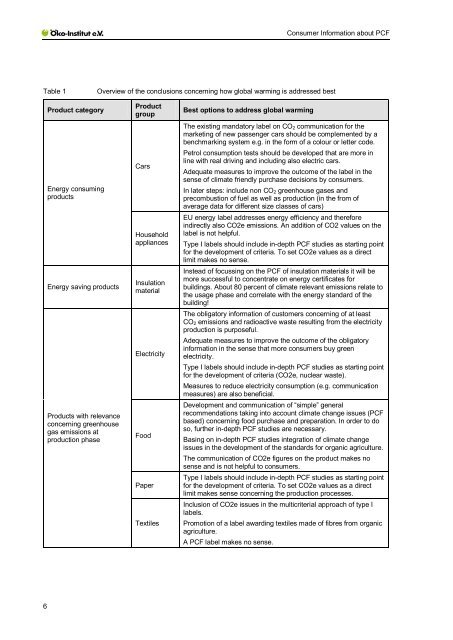Requirements on Consumer Information about Product ... - ANEC
Requirements on Consumer Information about Product ... - ANEC
Requirements on Consumer Information about Product ... - ANEC
Create successful ePaper yourself
Turn your PDF publications into a flip-book with our unique Google optimized e-Paper software.
C<strong>on</strong>sumer Informati<strong>on</strong> <strong>about</strong> PCF<br />
Table 1<br />
Overview of the c<strong>on</strong>clusi<strong>on</strong>s c<strong>on</strong>cerning how global warming is addressed best<br />
<strong>Product</strong> category<br />
Energy c<strong>on</strong>suming<br />
products<br />
Energy saving products<br />
<strong>Product</strong>s with relevance<br />
c<strong>on</strong>cerning greenhouse<br />
gas emissi<strong>on</strong>s at<br />
producti<strong>on</strong> phase<br />
<strong>Product</strong><br />
group<br />
Cars<br />
Household<br />
appliances<br />
Insulati<strong>on</strong><br />
material<br />
Electricity<br />
Food<br />
Paper<br />
Textiles<br />
Best opti<strong>on</strong>s to address global warming<br />
The existing mandatory label <strong>on</strong> CO 2 communicati<strong>on</strong> for the<br />
marketing of new passenger cars should be complemented by a<br />
benchmarking system e.g. in the form of a colour or letter code.<br />
Petrol c<strong>on</strong>sumpti<strong>on</strong> tests should be developed that are more in<br />
line with real driving and including also electric cars.<br />
Adequate measures to improve the outcome of the label in the<br />
sense of climate friendly purchase decisi<strong>on</strong>s by c<strong>on</strong>sumers.<br />
In later steps: include n<strong>on</strong> CO 2 greenhouse gases and<br />
precombusti<strong>on</strong> of fuel as well as producti<strong>on</strong> (in the from of<br />
average data for different size classes of cars)<br />
EU energy label addresses energy efficiency and therefore<br />
indirectly also CO2e emissi<strong>on</strong>s. An additi<strong>on</strong> of CO2 values <strong>on</strong> the<br />
label is not helpful.<br />
Type I labels should include in-depth PCF studies as starting point<br />
for the development of criteria. To set CO2e values as a direct<br />
limit makes no sense.<br />
Instead of focussing <strong>on</strong> the PCF of insulati<strong>on</strong> materials it will be<br />
more successful to c<strong>on</strong>centrate <strong>on</strong> energy certificates for<br />
buildings. About 80 percent of climate relevant emissi<strong>on</strong>s relate to<br />
the usage phase and correlate with the energy standard of the<br />
building!<br />
The obligatory informati<strong>on</strong> of customers c<strong>on</strong>cerning of at least<br />
CO 2 emissi<strong>on</strong>s and radioactive waste resulting from the electricity<br />
producti<strong>on</strong> is purposeful.<br />
Adequate measures to improve the outcome of the obligatory<br />
informati<strong>on</strong> in the sense that more c<strong>on</strong>sumers buy green<br />
electricity.<br />
Type I labels should include in-depth PCF studies as starting point<br />
for the development of criteria (CO2e, nuclear waste).<br />
Measures to reduce electricity c<strong>on</strong>sumpti<strong>on</strong> (e.g. communicati<strong>on</strong><br />
measures) are also beneficial.<br />
Development and communicati<strong>on</strong> of “simple” general<br />
recommendati<strong>on</strong>s taking into account climate change issues (PCF<br />
based) c<strong>on</strong>cerning food purchase and preparati<strong>on</strong>. In order to do<br />
so, further in-depth PCF studies are necessary.<br />
Basing <strong>on</strong> in-depth PCF studies integrati<strong>on</strong> of climate change<br />
issues in the development of the standards for organic agriculture.<br />
The communicati<strong>on</strong> of CO2e figures <strong>on</strong> the product makes no<br />
sense and is not helpful to c<strong>on</strong>sumers.<br />
Type I labels should include in-depth PCF studies as starting point<br />
for the development of criteria. To set CO2e values as a direct<br />
limit makes sense c<strong>on</strong>cerning the producti<strong>on</strong> processes.<br />
Inclusi<strong>on</strong> of CO2e issues in the multicriterial approach of type I<br />
labels.<br />
Promoti<strong>on</strong> of a label awarding textiles made of fibres from organic<br />
agriculture.<br />
A PCF label makes no sense.<br />
6
















